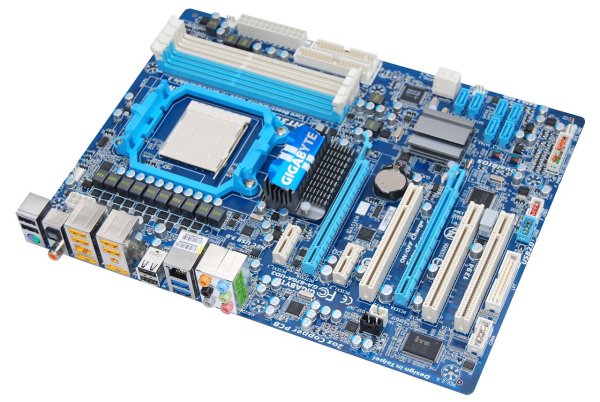Gigabyte 870A-UD3 – Design
As a standard ATX motherboard, the Gigabyte 870A-UD3 has much more room to play with compared to the Asrock board. All of a sudden it hits us how things have changed in the motherboard world.
Just like the Asrock, this Gigabyte budget motherboard looks very impressive and at first glance could easily pass as a more expensive high-end motherboard.



The cooling setup is very similar to that of the Asrock. We have a reasonably large north bridge heatsink followed by a smaller south bridge heatsink, while the power phase circuitry has been left naked. Given that the AMD 870 is the most energy-efficient chipset of the new 8-series, using just 12.5 watts of power, the configuration used by Gigabyte seems appropriate.

Although the AMD 870 chipset only supports up to 22 PCI Express 2.0 lanes, users can still use dual graphics cards if they wish. The board is configured with a primary PCIe x16 slot and a secondary one wired for x4 bandwidth. This bandwidth limitation could hurt Crossfire performance, so we generally recommend avoiding such a configuration.
Expansion slots include two PCIe x1 (share bandwidth with the secondary PCIe x16 port), two PCIe x16 and three traditional PCI slots. We like how Gigabyte has separated the two PCIe x16 slots using a PCIe x1 and a PCI slot on the 870A-UD3. If you were to use two graphics cards, there would still be plenty of breathing room between them.

Despite being a much larger motherboard than the Asrock 880GMH/USB3, the CPU socket is placed even closer to the DIMM slots. This means that low profile memory modules must be used when installing larger tower CPU coolers. Fortunately, the DIMM slots didn't conflict with the primary PCIe x16 slot, making it possible to install or remove memory with a graphics card installed.

Although the CPU socket is a little more crammed than we would have liked, Gigabyte has provided a rather impressive 8+2 power phase design. They have also included an 8-pin 12v ATX power connector and claim support for 140 watt CPUs as well as the new Phenom II X6 series.

Moving to the board's bottom right hand corner we find a number of SATA ports that have been mounted vertically. This is quite an oversight by Gigabyte as it means that those wanting to use Crossfire technology will have to sacrifice four SATA 6Gb/s ports, since access to them would be blocked by the second graphics card. Running a pair of Radeon HD 5770 cards has proven to be a popular option among gamers on a budget, so here's a warning flag for the 870A-UD3's design.
Had Gigabyte mounted these ports at a 90-degree angle on the edge of the motherboard this issue could have been avoided. The two ports connected to the JMicron JMB363 controller which are color coded white have been mounted at a 90-degree angle, yet they're not positioned behind either of the PCIe x16 ports.

On the I/O panel there's a single PS/2 port, eight USB 2.0 ports, two USB 3.0 ports, two eSATA ports, two Firewire ports, Ethernet port, S/PDIF In/Out ports and six audio jacks. The only thing missing which you might find on a more expensive $200+ motherboard is a second network port. In other words, the Gigabyte 870A-UD3 is extremely well equipped.